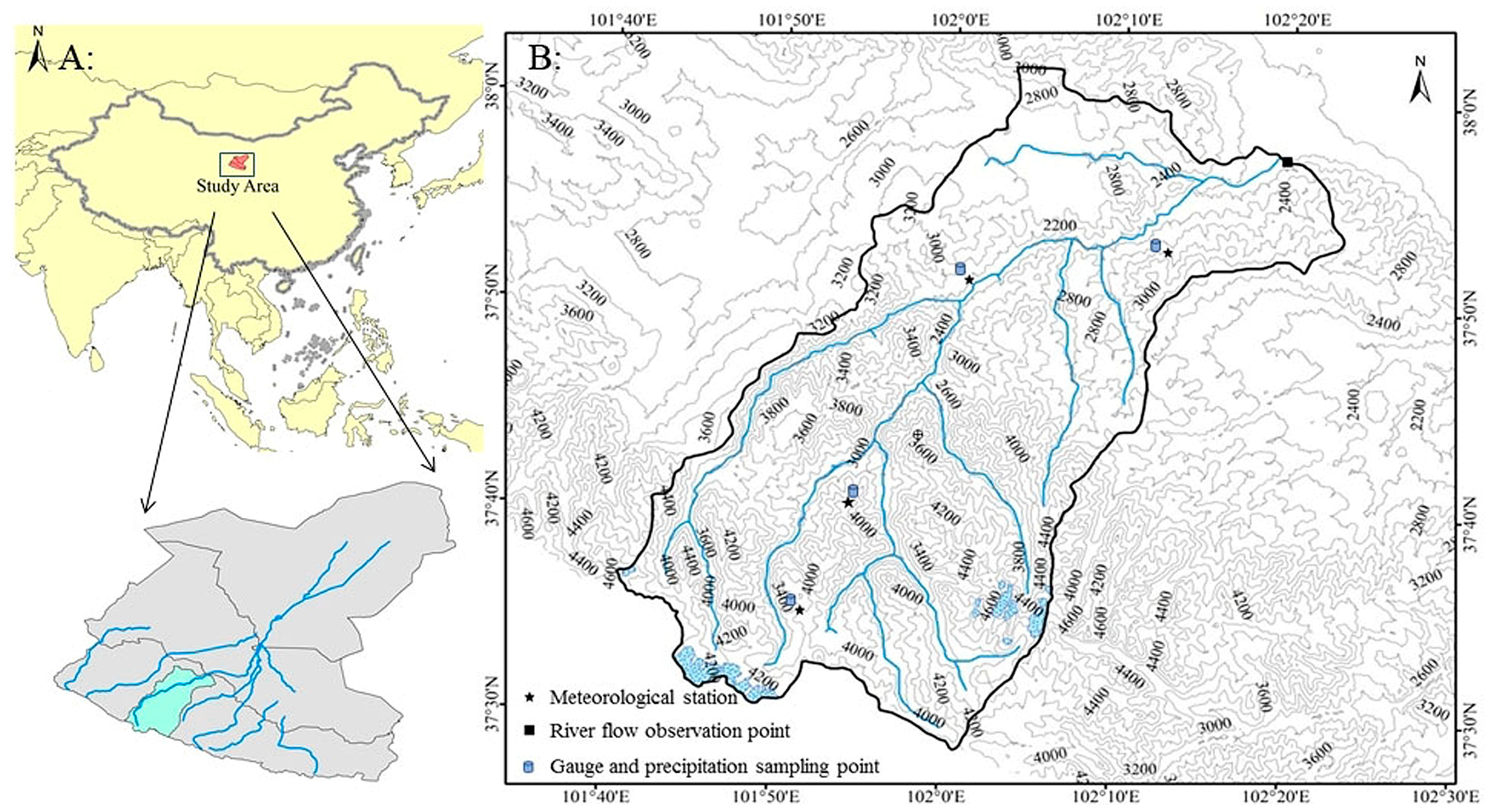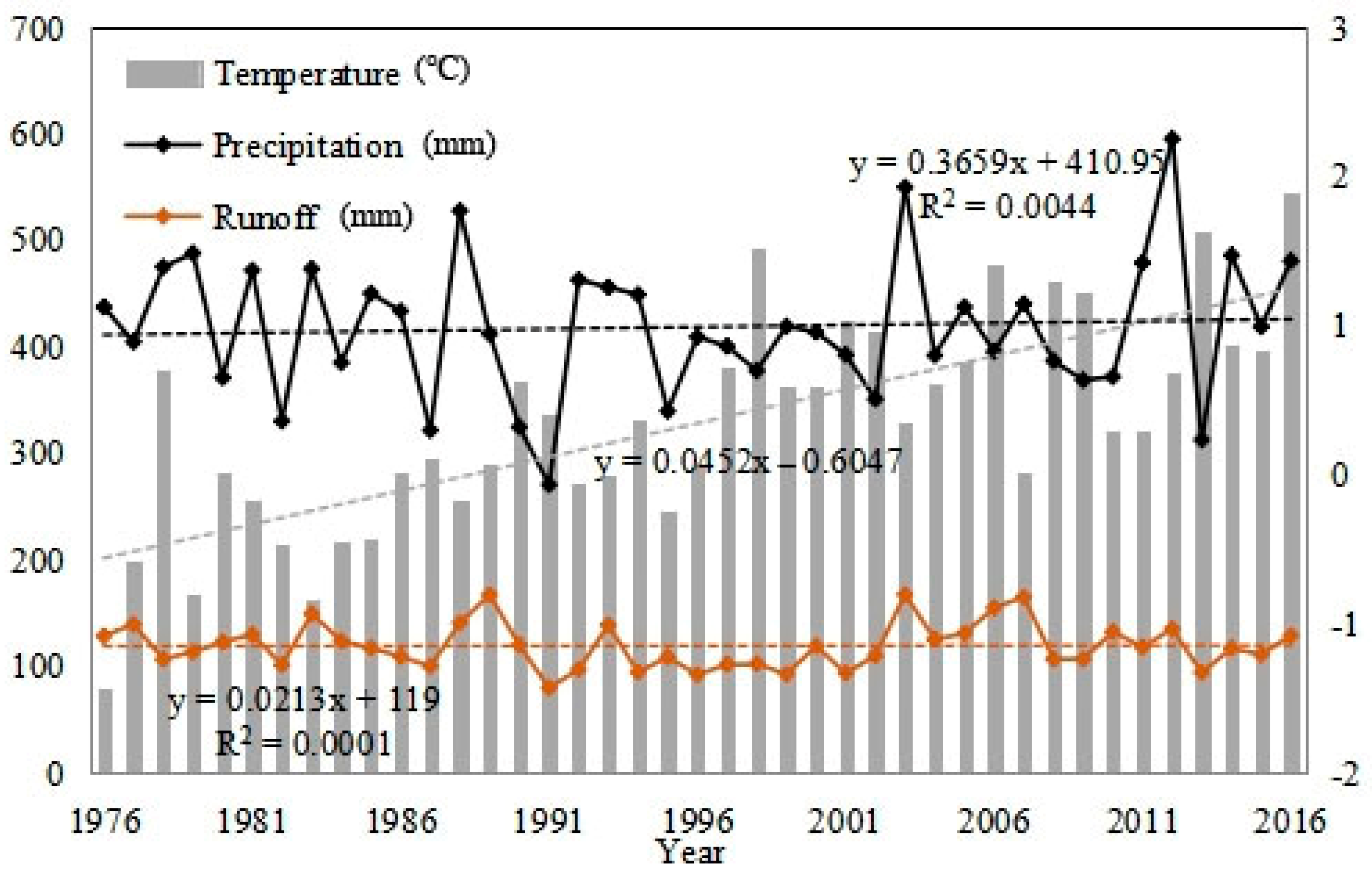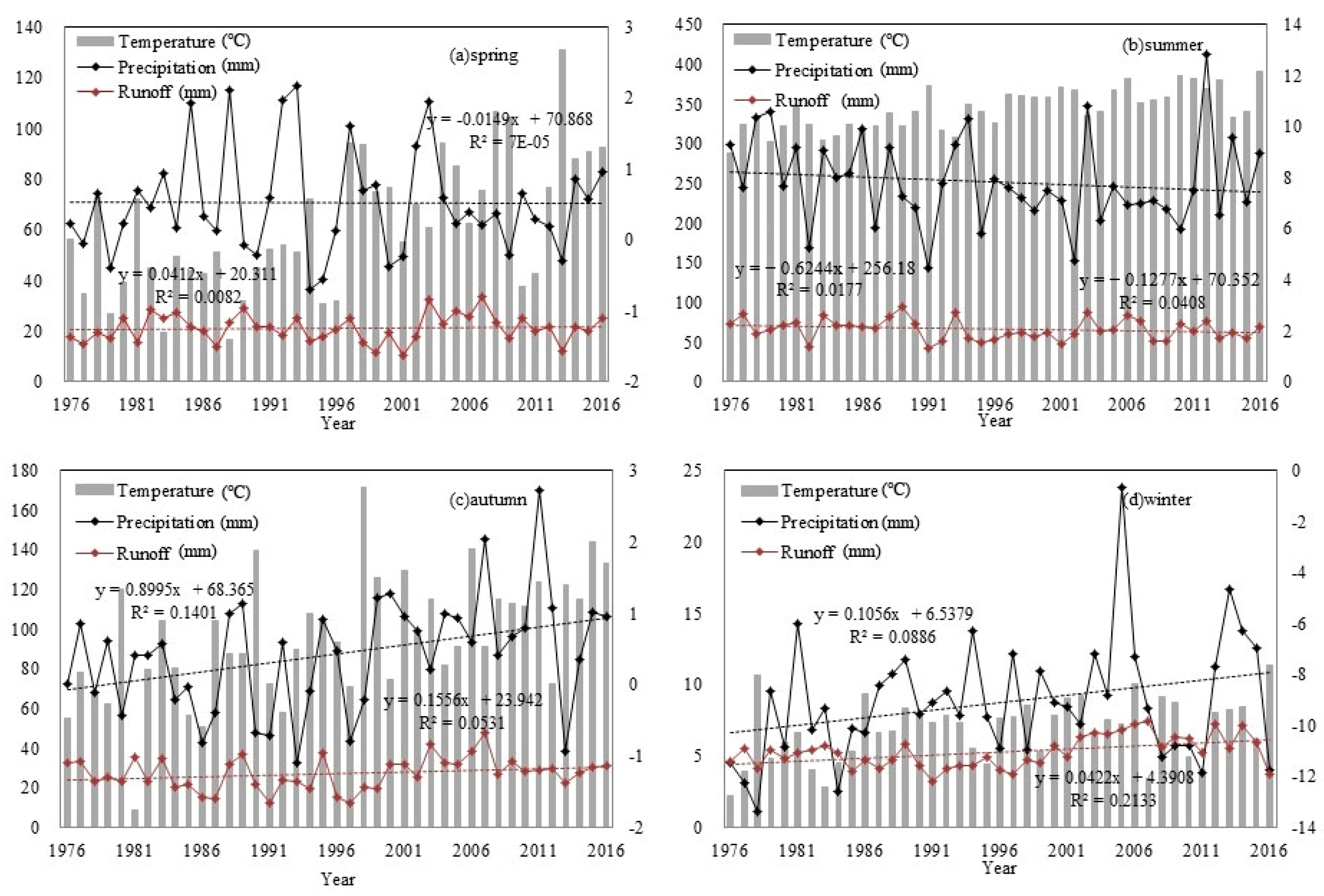Influence of Climate and Land Use Change on Runoff in Xiying River
Abstract
1. Introduction
2. Study Area and Data
2.1. Study Area
2.2. Data
3. Method
3.1. Calculation Method of Temperature Contribution in Different Seasons
3.2. Calculation Method of Contribution Rate of Runoff Change
3.3. Acquisition and Interpolation of Meteorological Data
3.4. Mann–Kendall Trend Test and Mutation Test
3.5. Analysis on the Dynamic Change in Land Use and Transfer of Land Use Types
- (1)
- Dynamic change in land use
- (2)
- Analysis of land use type transfer
4. Results
4.1. Changes of Hydrological and Climatic Factors in Xiying River
4.2. Correlation of Hydrological and Climatic Factors in the Xiying River
4.3. Land Use Change in Xiying River
5. Discussion
5.1. Influence of Temperature on Runoff Change in Xiying River
5.2. Influence of Precipitation on Runoff Change in the Xiying River
5.3. Influence of Land Use Change on Runoff Change
5.4. Uncertainty Analysis
6. Conclusions
- (1)
- Runoff in the Xiying River demonstrated a modest upward trajectory over the observed period. Among them, the autumn runoff showed a significantly increasing trend; the annual runoff change trend was not significant because the runoff change trend in the wet season (summer) was not significant.
- (2)
- From 1976 to 2016, the annual average temperature showed an upward trend in the Xiying River Basin, especially since 2000. Seasonal temperature trends indicated a consistent warming pattern, with summer temperature increases contributing most significantly—approximately 33%—to the annual mean temperature rise. Basin-wide annual precipitation exhibited fluctuating characteristics with a progressive increasing trend, characterized by statistically significant precipitation increments across all seasonal periods.
- (3)
- The land use types were mainly forestland, grassland, and unused land in the Xiying River, and the change in land use structure was not significant. Land use composition demonstrated a dynamic transformation, with cultivated land and forestland proportions progressively increasing, while grassland and construction land percentages simultaneously declined. Water area and unused land exhibited minimal morphological alterations. Expanding forestland coupled with reduced grassland and construction land areas progressively amplified the watershed’s water conservation capacity, subsequently diminishing runoff production potential and potentially modulating future hydrological dynamics.
- (4)
- On the interannual scale, the distribution law of precipitation and runoff was consistent. The influence of precipitation on runoff mainly occurred from May to September, when precipitation was relatively abundant. During cold-season periods (spring and winter), temperature emerged as the dominant control on runoff variability, exhibiting a statistically significant correlation with discharge patterns compared to precipitation’s marginal influence. This regime shift coincided with sustained positive temperature anomalies driving cryospheric melt contributions, where thermal forcing-initiated meltwater generation from glaciers and seasonal snowpack. At this time, evaporation was weak, which led to the increase in runoff in the Xiying River.
Author Contributions
Funding
Data Availability Statement
Conflicts of Interest
References
- Laurent, L.; Ullmann, A.; Castel, T. How Have Atmospheric Components of the Local Water Cycle Changed around the Abrupt Climatic Shift over France? J. Hydrol. 2024, 645, 132211. [Google Scholar] [CrossRef]
- Arnell, N.W.; Gosling, S.N. The Impacts of Climate Change on River Flow Regimes at the Global Scale. J. Hydrol. 2013, 486, 351–364. [Google Scholar] [CrossRef]
- Wang, Y.; Ye, A.; Zhang, Y.; Yang, F. The Quantitative Attribution of Climate Change to Runoff Increase over the Qinghai-Tibetan Plateau. Sci. Total Environ. 2023, 897, 165326. [Google Scholar] [CrossRef]
- Ni, Y.; Yu, Z.; Lv, X.; Qin, T.; Yan, D.; Zhang, Q.; Ma, L. Spatial Difference Analysis of the Runoff Evolution Attribution in the Yellow River Basin. J. Hydrol. 2022, 612, 128149. [Google Scholar] [CrossRef]
- Liang, S.; Wang, W.; Zhang, D.; Li, Y.; Wang, G. Quantifying the Impacts of Climate Change and Human Activities on Runoff Variation: Case Study of the Upstream of Minjiang River, China. J. Hydrol. Eng. 2020, 25, 05020025. [Google Scholar] [CrossRef]
- Xu, J.; Chen, Y.; Ji, M.; Lu, F. Climate Change and Its Effects on Runoff of Kaidu River, Xinjiang, China: A Multiple Time-Scale Analysis. Chin. Geogr. Sci. 2008, 18, 331–339. [Google Scholar] [CrossRef]
- Xu, J.; Chen, Y.; Li, W.; Yang, Y.; Hong, Y. An Integrated Statistical Approach to Identify the Nonlinear Trend of Runoff in the Hotan River and Its Relation with Climatic Factors. Stoch. Environ. Res. Risk Assess. 2011, 25, 223–233. [Google Scholar] [CrossRef]
- Li, Z.; Qi, F.; Wang, Q.J.; Song, Y.; Li, J.; Li, Y.; Wang, Y. Quantitative Evaluation on the Influence from Cryosphere Meltwater on Runoff in an Inland River Basin of China. Glob. Planet. Change 2016, 143, 189–195. [Google Scholar] [CrossRef]
- Xiong, L.; Yu, K.; Zhang, H.; Zhang, L. Annual Runoff Change in the Headstream of Yangtze River and Its Relation to Precipitation and Air Temperature. Hydrol. Res. 2013, 44, 850–874. [Google Scholar] [CrossRef]
- Tian, J.; Guo, S.; Yin, J.; Pan, Z.; Xiong, F.; He, S. Quantifying Both Climate and Land Use/Cover Changes on Runoff Variation in Han River Basin, China. Front. Earth Sci. 2022, 16, 711–733. [Google Scholar] [CrossRef]
- Deng, X.; Shi, Q.; Zhang, Q.; Shi, C.; Yin, F. Impacts of Land Use and Land Cover Changes on Surface Energy and Water Balance in the Heihe River Basin of China, 2000-2010. Phys. Chem. Earth 2015, 79–82, 2–10. [Google Scholar] [CrossRef]
- Hu, J.; Wu, Y.; Wang, L.; Sun, P.; Zhao, F.; Jin, Z.; Wang, Y.; Qiu, L.; Lian, Y. Impacts of Land-Use Conversions on the Water Cycle in a Typical Watershed in the Southern Chinese Loess Plateau. J. Hydrol. 2021, 593, 125741. [Google Scholar] [CrossRef]
- Sun, M.; Liu, S.; Yao, X.; Guo, W.; Xu, J. Glacier Changes in the Qilian Mountains in the Past Half-Century: Based on the Revised First and Second Chinese Glacier Inventory. J. Geogr. Sci. 2018, 28, 206–220. [Google Scholar] [CrossRef]
- Yang, J.; Zheng, W.; Wang, Y.; Bi, H.; Zhang, D.; Zhang, P.; Chen, G.; Wang, W. Quantitative Geomorphological Constraints on the Landform Evolution of the Current Active Boundary of the Northeastern Tibetan Plateau. Geomorphology 2020, 358, 107120. [Google Scholar] [CrossRef]
- Guo, X.; Wang, L.; Ma, F.; Tankpa, V.; Jiang, X.; Li, Z. Pathway Analysis to Quantify the Relationship between Runoff and Meteorological Factors in Re-Identifying Seasonality throughout the Ashi River Watershed, Northeast China. Theor. Appl. Climatol. 2021, 143, 1047–1061. [Google Scholar] [CrossRef]
- Characteristics Analysis of Spatial and Temporal Variation on Extreme Weather Events in Anhui Province for Recent 50 Years | Natural Hazards. Available online: https://link.springer.com/article/10.1007/s11069-017-2995-z (accessed on 23 May 2025).
- Moisa, M.B.; Busha Hinkosa, L.; Negasa, G.F.; Olika, G.; Ijigu, T.E.; Wedajo, Y.N. GIS and Remote Sensing Based Analysis of Land Use and Land Cover Change in the Upper Anger Watershed, Western Ethiopia. Geol. Ecol. Landsc. 2025, 9, 542–551. [Google Scholar] [CrossRef]
- Deng, H.; Chen, Y.; Wang, H.; Zhang, S. Climate Change with Elevation and Its Potential Impact on Water Resources in the Tianshan Mountains, Central Asia. Glob. Planet. Change 2015, 135, 28–37. [Google Scholar] [CrossRef]
- Hao, G.; Li, J.; Li, K.; Huang, K.; Song, J.; Li, H. Improvement and Application Research of the SRM in Alpine Regions. Environ. Sci. Pollut. Res. 2019, 26, 36798–36811. [Google Scholar] [CrossRef]
- Verma, A.; Kumar, A.; Tiwari, S.K.; Bhambri, R.; Sain, K.; Rai, S.K.; Patidar, P. Heterogeneity in Glacio-Hydrological Processes and Estimation of Different Components in Streamflow from Central Himalayan Glaciers. J. Hydrol.-Reg. Stud. 2023, 49, 101495. [Google Scholar] [CrossRef]
- Feng, L.; Yang, D.; Huang, Y. Analysis of Runoff Characteristics and Contribution Rate in Xiying River Basin in the Eastern Qilian Mountains. E3S Web Conf. 2019, 136, 04014. [Google Scholar] [CrossRef]
- Lin, X.; Zhu, G.; Qiu, D.; Ye, L.; Liu, Y.; Jiao, Y.; Wang, L.; Zhao, K.; Zhang, W.; Liu, J.; et al. Climate and Landscape Control of Runoff Stable Isotopes in the Inland Mountain. J. Hydrol. Reg. Stud. 2024, 51, 101633. [Google Scholar] [CrossRef]
- Lutz, A.F.; Immerzeel, W.W.; Shrestha, A.B.; Bierkens, M.F.P. Consistent Increase in High Asia’s Runoff Due to Increasing Glacier Melt and Precipitation. Nat. Clim. Change 2014, 4, 587–592. [Google Scholar] [CrossRef]
- Anache, J.A.A.; Flanagan, D.C.; Srivastava, A.; Wendland, E.C. Land Use and Climate Change Impacts on Runoff and Soil Erosion at the Hillslope Scale in the Brazilian Cerrado. Sci. Total Environ. 2018, 622–623, 140–151. [Google Scholar] [CrossRef] [PubMed]
- Wang, X.; He, K.; Dong, Z. Effects of Climate Change and Human Activities on Runoff in the Beichuan River Basin in the Northeastern Tibetan Plateau, China. Catena 2019, 176, 81–93. [Google Scholar] [CrossRef]
- Wang, D.; Yu, X.; Jia, G.; Wang, H. Sensitivity Analysis of Runoff to Climate Variability and Land-Use Changes in the Haihe Basin Mountainous Area of North China. Agric. Ecosyst. Environ. 2019, 269, 193–203. [Google Scholar] [CrossRef]
- Yang, D.; Sun, F.; Liu, Z.; Cong, Z.; Ni, G.; Lei, Z. Analyzing Spatial and Temporal Variability of Annual Water-Energy Balance in Nonhumid Regions of China Using the Budyko Hypothesis. Water Resour. Res. 2007, 43, W04426. [Google Scholar] [CrossRef]
- Oudin, L.; Andréassian, V.; Lerat, J.; Michel, C. Has Land Cover a Significant Impact on Mean Annual Streamflow? An International Assessment Using 1508 Catchments. J. Hydrol. 2008, 357, 303–316. [Google Scholar] [CrossRef]
- Olofsson, P.; Foody, G.M.; Herold, M.; Stehman, S.V.; Woodcock, C.E.; Wulder, M.A. Good Practices for Estimating Area and Assessing Accuracy of Land Change. Remote Sens. Environ. 2014, 148, 42–57. [Google Scholar] [CrossRef]






| Spring | Summer | Autumn | Winter | Annual | |
|---|---|---|---|---|---|
| Temperature: Z | 4.02 ** | 4.93 ** | 3.83 ** | 2.58 ** | 5.20 ** |
| Precipitation: Z | 0.17 | 1.72 * | 2.24 ** | 1.65 * | −0.10 |
| Runoff: Z | 0.51 | −1.02 | 1.04 | 2.57 ** | −0.01 |
| Time Scale | Xiying River | |
|---|---|---|
| Precipitation | Temperature | |
| January | 0.007 * | 0.168 ** |
| February | 0.369 ** | 0.309 ** |
| March | −0.098 ** | 0.487 ** |
| April | −0.192 ** | 0.492 ** |
| May | −0.006 ** | 0.217 ** |
| June | 0.278 ** | −0.270 ** |
| July | 0.474 ** | −0.250 ** |
| August | 0.500 ** | −0.0458 ** |
| September | 0.432 ** | 0.036 ** |
| October | 0.659 ** | 0.154 ** |
| November | 0.395 | 0.035 ** |
| December | 0.038 ** | −0.031 ** |
| Spring | 0.316 ** | −0.149 ** |
| Summer | 0.414 ** | −0.262 ** |
| Autumn | 0.628 ** | 0.062 ** |
| Winter | 0.325 ** | −0.055 ** |
| Annual | 0.465 ** | −0.206 ** |
| Project | Types | Grassland | Cultivated Land | Construction Land | Forestland | Water Area | Unused Land | Total |
|---|---|---|---|---|---|---|---|---|
| Area (1980–2018) | Grassland | 708.29 | 24.24 | 1.00 | 181.88 | 1.06 | 95.85 | 1012.32 |
| Cultivated land | 22.04 | 5.39 | 3.12 | 30.55 | ||||
| Construction land | 1.65 | 0.03 | 1.68 | |||||
| Forestland | 166.50 | 5.66 | 167.27 | 6.25 | 345.68 | |||
| Water area | 1.96 | 0.03 | 0.06 | 2.05 | ||||
| Unused land | 91.06 | 6.39 | 1.91 | 168.64 | 268.00 | |||
| Total | 991.50 | 35.32 | 1.00 | 358.66 | 3.00 | 270.80 | 1660.28 |
| Month | 1 | 2 | 3 | 4 | 5 | 6 | 7 | 8 | 9 | 10 | 11 | 12 |
|---|---|---|---|---|---|---|---|---|---|---|---|---|
| Precipitation | 2.55 | 4.50 | 5.71 | 1.82 | 18.06 | 25.38 | 21.60 | 12.83 | 44.49 | 30.35 | 6.56 | 26.14 |
| Temperature | 0.45 | 0.15 | 1.84 | 12.06 | 18.82 | 74.79 | 23.30 | 21.37 | 32.22 | 10.20 | 3.10 | 1.70 |
Disclaimer/Publisher’s Note: The statements, opinions and data contained in all publications are solely those of the individual author(s) and contributor(s) and not of MDPI and/or the editor(s). MDPI and/or the editor(s) disclaim responsibility for any injury to people or property resulting from any ideas, methods, instructions or products referred to in the content. |
© 2025 by the authors. Licensee MDPI, Basel, Switzerland. This article is an open access article distributed under the terms and conditions of the Creative Commons Attribution (CC BY) license (https://creativecommons.org/licenses/by/4.0/).
Share and Cite
Yan, P.; Wang, Q.; Wang, J.; Peng, J.; Zhu, G. Influence of Climate and Land Use Change on Runoff in Xiying River. Land 2025, 14, 1381. https://doi.org/10.3390/land14071381
Yan P, Wang Q, Wang J, Peng J, Zhu G. Influence of Climate and Land Use Change on Runoff in Xiying River. Land. 2025; 14(7):1381. https://doi.org/10.3390/land14071381
Chicago/Turabian StyleYan, Peizhong, Qingyang Wang, Jianjun Wang, Jianqing Peng, and Guofeng Zhu. 2025. "Influence of Climate and Land Use Change on Runoff in Xiying River" Land 14, no. 7: 1381. https://doi.org/10.3390/land14071381
APA StyleYan, P., Wang, Q., Wang, J., Peng, J., & Zhu, G. (2025). Influence of Climate and Land Use Change on Runoff in Xiying River. Land, 14(7), 1381. https://doi.org/10.3390/land14071381






